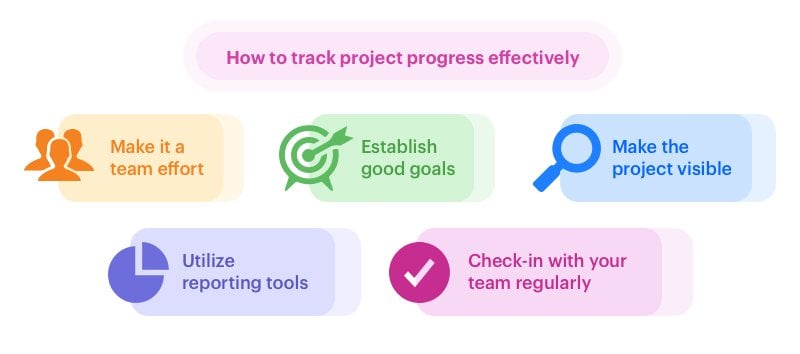You’ve just been handed a new project. You have a vision for what the finished product will be and a great team to help you get there. Things are off to a good start.
All too often, however, things go off track while managing projects. Rates vary among industries, but the Project Management Institute reports that somewhere around 15% of projects are considered total failures. Of those that succeed, nearly half fail to meet commitments of time, 43% run over budget, and 32% fall short of some aspect of product delivery.
What can you do to prevent your project from failing? If time, money, and product are the three most common stumbling blocks, what can you do to create successful outcomes in those areas? Track the progress of your project.
It may sound too simple to be the key to success, but monitoring project progress can make all the difference between success and project failure. It doesn’t need to be complicated, and with a bit of dedication, you can lead your team to successful project completion.
Challenges in tracking project progress
While staying updated on project progress is critical, it is often difficult. Here are just a few challenges that make tracking project progress difficult:
- Often many projects are not planned and documented in detail
- Project task allocation is sometimes arbitrary, making tracking difficult.
- Many projects lack proper communication and so everyone is not on the same page.
- Frequent update meetings are not implemented in some projects.
- Many projects don’t utilize google project management tools that make integration with google apps for efficient tracking.
Getting past the challenges in tracking projects can be done by reversing one or more aspects mentioned above.
How to track project progress effectively

Here are the five tips you can effectively measure project progress in project management:
1. Make it a team effort
Everyone on your team wants the same thing: a successful project. With that in mind, get everyone involved by holding a kickoff meeting, sharing your vision and the client’s motivations, and soliciting input from your team.
It’s especially important that your project team members contribute to establishing your goals since it is largely up to those individuals to meet the project goals.
Schedule Kissflow personalized demo
2. Utilize reporting tools to monitor project progress
It is extremely helpful to utilize a project management software to generate automatic reports on your progress. Rather than you assessing progress toward deadlines individually or attempting to calculate percentages of completion, a project reporting feature in the project management system can give you accurate information in just a few clicks.
3. Establish good goals
You can’t track what you haven’t established. Good goals are realistic, clear, and measurable. Write down a rough sketch of your project objectives, and then examine them to see if they meet the following requirements:
- Realistic– Having lofty goals is good, and stretch goals can be a great way to challenge your team, but always keep things realistic. You don’t want to make promises to your clients that you can’t keep. Ask yourself: Can we accomplish this goal with the allotted time and resources available to us?
- Clear– Many project managers cite a lack of clear goals as the most common cause of project failures. Ask yourself: Do we know exactly what is being asked of us? Does everyone on the team understand?
- Measurable– It’s not enough to say “finish phase one in a timely manner” or “increase capacity” for example. You need numbers. Decide what date phase one should be completed and establish your baseline, acceptable, and ideal numbers for capacity. Ask yourself: Are there quantifiable indicators with which we can judge each goal?
4. Make the project visible
One of the best ways to promote success is to make the project visible to everyone on your team. It’s extremely motivating when your team can see the goals they’ve helped establish as well as the progress being made (or not made) toward those goals.
The Kanban method is a simple and effective visual system for organizing workflows. It helps prevent bottlenecks, encourages incremental improvements, and balances demands against available capacity. Kanban boards can be physical in the form of sticky notes placed on an empty wall, or you can go digital with online workplaces shared around the globe.
First, identify the steps or project phases of your workflow and create a column for each one. Second, create a card for each task or project element that needs to be completed. Third, put your cards into the columns that represent where each task or project stands in the workflow. As tasks move from one phase to the next, move the card to the next column until it has passed through all the phases of your workflow.
Everyone on the team can see at a glance how tasks are moving through the phases. This lets each team member know who’s waiting, who needs help, what tasks are late, and what needs to be done next.
5. Check-in with your team regularly
Be consistent. Don’t be tempted to “set it and forget it.” Create a project schedule for yourself to check in on the goals you’ve created with your team. Deadlines are obvious points, but if you wait until the deadline, it will be too late to course-correct. Instead of taking this reactive approach, be proactive.
Set appointments for yourself to measure progress at regular intervals throughout the project. Then you can address issues early on and keep your project on track.
Bonus – Use a project management tool
A quality project tracking software can make all the difference to your project. Many of the top tools on the market come with efficient tracking capabilities. These capabilities take the effort of tracking away from the project manager.
Most tools make it possible to receive emails when a project phase or task is nearing completion or when a deadline looms. Additionally, quality tools provide a variety of ways in which to visualize projects better to get to the required information faster.
Track project progress effectively with Kissflow Project
It’s possible to follow most of the steps outlined above with a patchwork of tools from sticky notes to email to spreadsheet alternative, but there’s a better way. Kissflow Project is a comprehensive project management tool that allows you to collaborate effectively, visualize with Kanban boards, generate reports, and do much more.
Kissflow Project makes tracking a breeze with notifications for pending deadlines and measurements of time overruns for tasks. Additionally, it provides a variety of views and real-time views to take the demands of tracking away from you.
Kissflow Project
- is simple and intuitive to use,
- frees you from constantly tracking teammates,
- offers multiple views to visualize projects
- provides “Done”, “In-Progress”, and “On Hold” states for clarity on status,
- gives you access to powerful reports to make data-driven decisions, and
- reminds you when tasks near their deadlines.
To see how you can track your projects all the way to success, sign up today and start using Kissflow Project for free. Start using the Kissflow Platform today to enhance your project management efficiency.
Your search for Project management has landed you here. Wondering why?
As a user, you'll experience the full value of Kissflow by implementing it across departments for diverse use cases rather than just addressing isolated needs like a project management tool for a single team or department.


.png?width=2000&name=PSE%20Dashboard%20(3).png)
.png?width=2000&name=LM%20Dashboard%20(3).png)
.png?width=2000&name=Dashboard%20(3).png)




